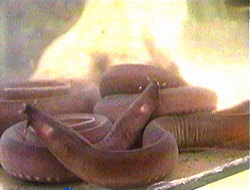
The adjective which best describes the Myxini is "Lovecraftian". Hagfish are long, slender and pinkish, and are best known for the large quantities of sticky slime which they produce. Hagfish have three accessory hearts, no cerebrum or cerebellum, no jaws or stomach, and will "sneeze" when their nostrils clog with their own slime. They are found in cold ocean waters of both hemispheres, scavenging dead and dying fish but also preying on small invertebrates.
Hagfish are almost blind, but have well developed senses of touch and smell. They have four pairs of sensing tentacles arranged around their mouth. The mouth lacks jaws, but a hagfish is equipped with two pairs of tooth-like rasps on the top of a tongue-like projection. As this tongue is pulled back into the hagfish's mouth, the pairs of rasps pinch together. This bite is used to tear into the flesh of dead and dying fish which have sunk to the muddy ocean bottom, or in catching and eating marine invertebrates. By far, the largest part of their diet is polychaete worms, but because of their slow metabolism, hagfish may go for up to seven months without eating any food.
Unlike many other fish, the Myxini undergo direct development, with no larval stage. The newly hatched young are practically miniature versions of their parents. Young are hermaphroditic at first, bearing both sets of sex organs; later in life, they will be either male or female, but may change sex from season to season.
Hagfish eggs are approximately one inch long, and encased in a tough shell. These eggs are large for a fish, and a female can therefore not produce very many. Despite the low number of eggs laid, hagfish exist in large numbers, with populations of up to 15,000 occurring in a relatively small area. This suggests that hagfish have a low mortality rate.

The Myxini are unique among living chordates in that they have a partial cranium (skull), but no vertebrae, and so they are not truly vertebrates. The skeleton is composed of cartilage, and lacks bone. Hagfish also lack jaws, and for this reason were long classified together with the lampreys in a group called the Agnatha ("no jaws") or the Cyclostomata ("round mouth"). Jawlessness is the primitive state for fish however, and so any such group based on a lack of jaws is paraphyletic. View a cladogram of the groups of basal vertebrates for better understanding.
The only fossil hagfish is Myxinikela siroka, a Pennsylvanian find from the Francis Creek Shale of northeastern Illinois (Bardack, 1991). The fossil was found within a siderite (iron carbonate) concretion, and preserves the paired tentacles, internal organs, and detail of the head and jaws. The similarity to modern hagfishes is striking, and suggests that there has been little evolutionary change in this group over the last 300 million years. A similar fossil from the same strata, Gilpichthys, has been tentatively included with the hagfish, but lacks the distinctive tentacles of all other species.
Before the discovery of Myxinikela, there was much speculation concerning the relationship of the Myxini to other fish. With no fossils known, it was suggested that they were secondarily reduced and closely related to the Petromyzontiformes (lampreys). Even though evidence of their truly basal position was known (Stensiö, 1968), the lack of fossils made it difficult for people who study fish evolution to accept that the Myxini could have evolved so long ago. More complex fish show up as far back as 400 million years ago, so why weren't there any hagfish fossils? This story demonstrates that a lack of known fossils does not necessarily mean that a group is very young, and that a single fossil can be both very important and very persuasive.
Read about other fossils of the Francis Creek Shale at the Illinois State Museum.
For more hagfish information visit the Hagfish page on the Tree of Life.

D. Bardack. 1991. First fossil hagfish (Myxinoidea): a record from the Pennsylvanian of Illinois. Science 254:701-703.
D. Jensen. 1966. The hagfish. Scientific American 214(2):82-90.
E. Stensiö. 1968. The cyclostomes with special reference to the diphyletic origin of the Petromyzontida and Myxinoidea. In T. Orvig (ed.) Current problems of lower vertebrate phylogeny: Proceedings of the Fourth Nobel Symposium. Interscience Publishers, Stockholm.

